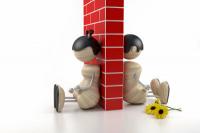Ride a horse with a spade?
A lameness that occurs at the beginning of riding, which disappears after a while because the horses have run in, indicates an incipient ossification of the ankle. This disease is also called spat. Horses with spars can be ridden in consultation with the veterinarian, but you should pay attention to important things.

What is Spat
- Spat is an incurable disease of the musculoskeletal system, the ankle joint of a horse is affected.
- This joint begins to ossify, in the final stage it is completely ossified.
- During the ossification phase, painful, acute inflammations in the joint occur again and again.
- As the spade progresses, mobility is increasingly restricted, and it can end in complete stiffening.
- In its beginnings, the spar shows itself through temporary lameness. the Horses run in and the lameness disappears. However, it occurs at the next ride at the beginning again.
- The further the spade progresses, the less expansive the horse can swing its leg and the steps are shortened. Sometimes they just drag their toes behind them.
- They are just as reluctant to lift their hooves because the movement in the joint is painful. This can make hoof care very difficult.
- Spat can have many causes, sometimes horses have a genetic predisposition. An incorrectly treated misalignment and incorrect fogging can also trigger the disease, a lack of movement does the rest. Incorrect feeding, in which the need for calcium is not adequately met, for example, can also trigger ossification. Last but not least, this is often due to a physical external impact on the leg or it is age-related.
Do your little protégés want nothing more than riding? A riding participation ...
The disease can have many causes, but veterinary treatment and treatment are definitely important Exact agreement on how the horse should be moved in the future, because correctly dosed movement is for late horses important.
There has to be a lot of movement
- First of all, animals suffering from this ankle ossification should not be locked in a box. Ideally, you should keep them in an open stall, in which they can move freely throughout the day. This is good for the joints, because they are constantly lubricated, as the synovial fluid only flows into the joints with movement.
- You should make sure that your horse with spar moves really a lot, take it for a long walk or regularly put it in a stepping machine.
- But it is also important that it does not stand together with other, rather wild horses, because scuffles with uncontrolled jumps to the side are to be avoided as far as possible. So it is better to put your sick animal in a herd of retirees, in which it is quiet.
How to properly ride the sick horses
- In consultation with the veterinarian, you can also ride your horse, but you should always take into account the shape of the day and the condition of the animal. Riding here only serves the well-being of the horse, not its own pleasure.
- It is very important that you give the horse enough time to break in so that the joints are adequately lubricated. You can still put it to the aids on the easily accepted reins.
- Avoid restlessness, the mount should not jump to the side under you.
- You can safely ride lots of large, curved lines if your horse goes along, shows himself willingly and the lameness goes away while riding.
- Slight side movements are also possible, but only depending on the horse's condition.
- Let it come up to the hand from the back to the front, because it is not healthy for a spade horse to just walk on the forehand all the time. However, weight absorption through the hindquarters should be attempted.
- But you should absolutely refrain from riding the sick animal into the meeting, because this is certainly very painful.
- So always be very attentive, the animal becomes clear to you with its possibilities Make people understand whether they are still feeling good or whether the riding begins to be uncomfortable or even painful will. In this case, you should stop immediately.
- Choosing the right floor is also very important because a hard floor such as asphalt is counterproductive and painful. But a bottom that is too deep is also not recommended, because here the animals usually step crooked, which in turn leads to pain.
- Animals with this disease should also be treated by the blacksmith regularly and at short intervals so that any deformities that develop can be corrected immediately.
Continuous consultation with the veterinarian is also important. He will tell you if you can ride your horse or when the time is better to stop.
How helpful do you find this article?


